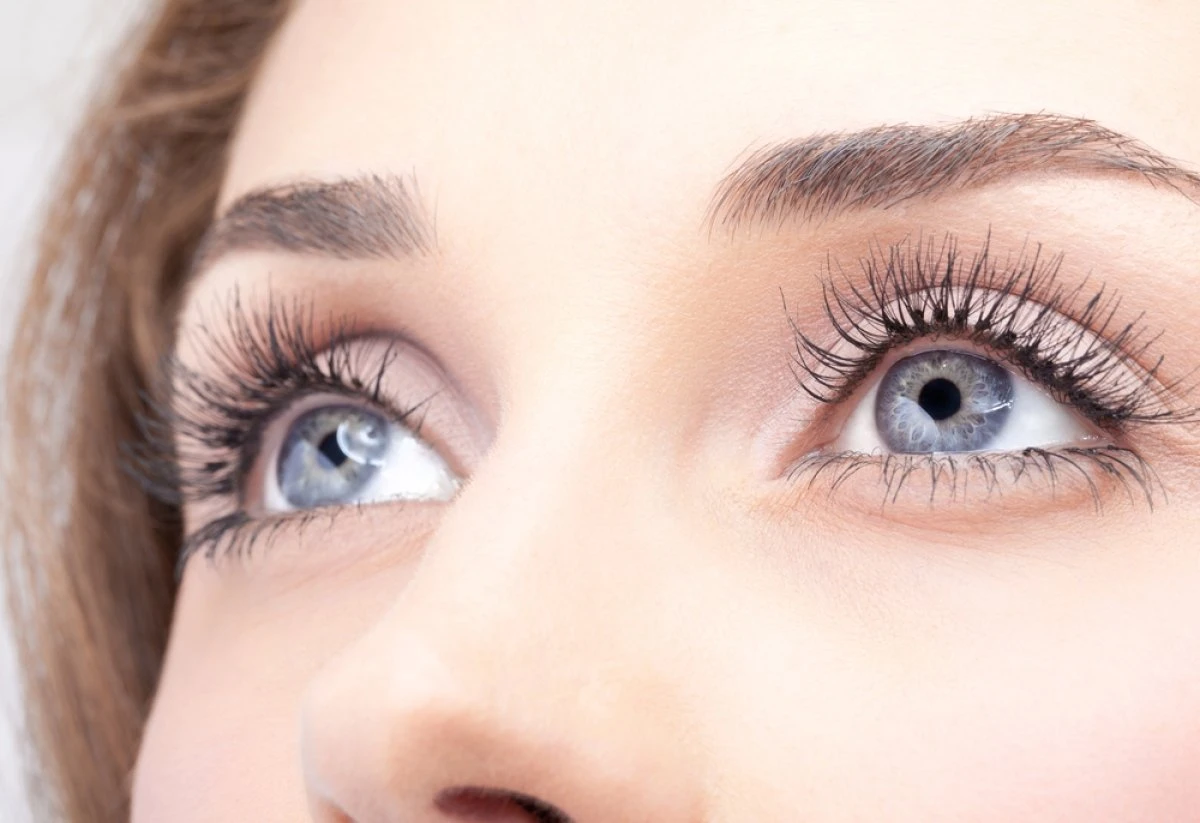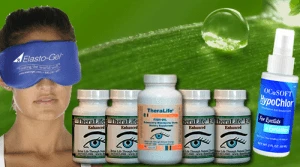TheraLife’s approach to blepharitis treatment is comprehensive, offering a range of products and solutions that benefit its customers by integrating natural and nutritional elements with cutting-edge science. The treatment begins with a focus on maintaining proper eyelid hygiene and using warm compresses to alleviate symptoms. TheraLife emphasizes the importance of incorporating omega-3 fatty acids and essential vitamins for reducing inflammation, as part of a holistic dietary strategy.
TheraLife’s product lineup includes over-the-counter options such as Tea Tree Oil, Hyaluronic Acid, and Hypochlorous acid, which provide significant relief for mild cases. For more severe or persistent blepharitis, TheraLife offers advanced solutions and prescription options tailored to the specific needs of the individual.
Moreover, TheraLife’s products are designed to address related conditions like dry eyes, uveitis, and eyelash mites, ensuring comprehensive eye health. Their approach includes guidance on dietary adjustments, such as anti-inflammatory diets, to further support eye wellness. By prioritizing natural remedies and customer education, TheraLife empowers individuals to manage blepharitis effectively and improve their overall eye health.
Best Blepharitis Treatment From TheraLife- When Drops Don’t Work.
Key Takeaways
- Consistent warm compresses and eyelid massage help loosen crusts and improve oil gland function.
- Regular eyelid hygiene with specialized cleansers reduces bacterial load and prevents blepharitis recurrence.
- Over-the-counter solutions like Tea Tree Oil and Hypochlorous acid reduce microbial presence and inflammation.
- Prescription treatments, including topical antibiotics and steroid drops, alleviate severe symptoms and inflammation.
- Advanced procedures, such as thermal pulsation therapy, effectively unblock meibomian glands and enhance eyelid hygiene.
Understanding Blepharitis: Symptoms and Causes
Blepharitis, though often overlooked, is a common inflammatory condition affecting the eyelids. You’re likely to encounter symptoms such as red, swollen eyelids and crusty debris at the base of your eyelashes. The condition arises from multiple blepharitis triggers, including bacterial infection, seborrheic dermatitis, and malfunctioning oil glands. These factors contribute to eyelid inflammation, disrupting the normal tear film, and causing discomfort. Your diagnosis should focus on identifying these triggers through a thorough clinical examination. Look for signs like oily flakes and collarettes around the eyelashes. You might also notice chronic eye irritation and a burning sensation. Understanding these symptoms and causes is essential for effective management. Accurate identification of eyelid inflammation sources will guide appropriate treatment interventions.
Warm Compresses: A Simple Yet Effective Remedy
You should consider warm compresses as an evidence-based strategy for managing blepharitis, as they help to loosen crusts and improve gland function. Clinical studies demonstrate that regular application can reduce eyelid inflammation and discomfort. Make certain you use proper techniques, such as applying the compress for 5-10 minutes, to optimize therapeutic outcomes. Randomized trials show improved resolution rates for eyelid lesions with consistent application of warm compresses, especially when combined with eyelid massage.
Benefits of Warm Compresses
When addressing blepharitis, the application of warm compresses emerges as a simple yet effective remedy. By delivering localized heat, warm compresses provide several benefits, particularly regarding eyelid inflammation relief.
The heat helps to:
- Loosen clogged oils in the meibomian glands, reducing eyelid margin inflammation.
- Enhance blood circulation, facilitating the delivery of nutrients and removal of waste products.
- Soften crusts and debris, promoting easier removal of irritants that contribute to inflammation.
- Relax muscle spasms, which can alleviate discomfort commonly associated with eyelid inflammation.
Regular eyelid hygiene is crucial to minimize symptom recurrence, and avoiding eye makeup during active blepharitis can help facilitate recovery. These benefits are well-documented, making warm compresses a recommended initial intervention for managing blepharitis symptoms.
The consistent use of this simple remedy can greatly improve the condition of your eyelids, offering relief from chronic irritation and discomfort.
Proper Application Techniques
To maximize the benefits of warm compresses for blepharitis, precise application techniques are essential.
Begin by selecting a clean, soft cloth and soak it in warm water—guaranteeing the temperature is comfortable to the touch. Wring out excess water to prevent drips.
Apply the compress gently against your closed eyelids, maintaining consistent pressure without causing discomfort. Hold for 5-10 minutes, reheating the cloth as necessary to maintain warmth.
This method facilitates the loosening of eyelid debris and promotes oil gland function. Repeat the application daily, focusing on the eyelid margins.
Proper techniques guarantee the compress remains effective, reducing inflammation and irritation associated with blepharitis. Consistent implementation of these application methods enhances therapeutic outcomes, providing sustained relief from symptoms. Regular warm compress use can also be beneficial for preventing chalazion recurrence, and it is supported by studies from the British Journal of Ophthalmology, which highlight its effectiveness in reducing chalazion size.
Eyelid Hygiene: The Importance of Regular Cleaning
While maintaining eyelid hygiene might seem trivial, it’s a critical component in managing and preventing blepharitis. Regular cleaning can reduce inflammation and bacterial load. Evidence suggests that incorporating effective cleaning techniques can greatly alleviate symptoms.
Here’s how you can maintain ideal eyelid health:
- Eyelid massage: Gently massage your eyelids to help express clogged glands. This promotes better oil flow and reduces crust formation.
- Warm compresses: Apply a warm compress to loosen debris and soften oils, making subsequent cleaning more effective.
- Cleaning solutions: Use a specialized eyelid cleanser or diluted baby shampoo to carefully clean your eyelid margins, removing bacteria and debris.
- Consistent routine: Establish a daily eyelid hygiene routine to prevent recurrence and maintain eyelid health.
- Omega-3 fatty acids: Incorporating omega-3 fatty acids into your diet can reduce inflammation and improve overall eyelid health.
Dietary Considerations for Eye Health
To effectively manage blepharitis, you should focus on incorporating essential nutrients like omega-3 fatty acids and vitamins A, C, and E, which support ocular health. Evidence suggests these nutrients may reduce inflammation and promote tear production, thereby alleviating symptoms. Additionally, it’s advisable to limit foods high in refined sugars and trans fats, as they can exacerbate inflammatory responses. The molecular distillation process used in TheraLife Omega-3 ensures the removal of impurities, such as heavy metals, enhancing the supplement’s quality and effectiveness in supporting eye health.
Essential Nutrients for Eyes
Maintaining ideal eye health requires a focus on essential nutrients that play a significant role in visual function. Ensuring a diet rich in these nutrients is essential to support and maintain optimal eye health.
Nutrient sources and eye supplements are fundamental in preventing or managing conditions like blepharitis. Consider incorporating these essential nutrients:
- Omega-3 fatty acids: Found in fish like salmon, these are crucial for retinal health and managing inflammation.
- Vitamin A: Essential for night vision, available in carrots and sweet potatoes.
- Lutein and Zeaxanthin: Present in leafy greens, they protect against harmful light exposure.
- Vitamin C: An antioxidant found in citrus fruits, it supports overall eye health.
*Chronic dry eyes exacerbate inflammation and discomfort*, making it crucial to balance nutrients to manage symptoms effectively.
Foods to Avoid
Which foods should you steer clear of to maintain ideal eye health? Certain snacks and spicy foods can exacerbate blepharitis symptoms, increasing irritation and inflammation in the eyes. High-sodium snacks may lead to fluid retention, affecting ocular hydration negatively. Spicy foods can increase blood flow and potentially lead to increased ocular surface inflammation. For people with thyroid disorders, dietary adjustments may be crucial in managing ocular health conditions like blepharitis. Evidence suggests that reducing intake of these items may alleviate discomfort associated with blepharitis. A diet high in sugar can lead to glycation, contributing to oxidative stress and compromising eye health. Prioritizing a balanced diet rich in essential nutrients can support ocular health and reduce blepharitis symptoms.
Over-the-Counter Treatments: What to Look For
When considering over-the-counter treatments for blepharitis, it’s crucial to focus on products containing ingredients that effectively alleviate inflammation and control bacterial growth.
The right over-the-counter options should incorporate active components known for their therapeutic benefits. Look for:
- Tea Tree Oil: Renowned for its antimicrobial properties, which can help reduce bacterial presence.
- Hyaluronic Acid: Provides moisture, reducing dryness and irritation associated with blepharitis.
- Benzalkonium Chloride: An antiseptic agent that aids in eliminating bacteria from eyelid margins.
- Liposomes: These help in delivering active ingredients deeper into the skin layers, enhancing efficacy.
Selecting products with these ingredients can be pivotal in managing blepharitis symptoms effectively. Hypochlorous acid solutions are also effective in reducing microbial load and inflammation, and they are recommended as part of a comprehensive blepharitis treatment plan.
Always read labels carefully and verify the product is suitable for your specific condition.
Prescription Medications: When to Seek Medical Help
While over-the-counter treatments can provide relief for mild symptoms of blepharitis, there are situations where prescription medications become necessary. If your symptoms persist or worsen, it’s vital to seek medical advice.
Prescription guidelines typically involve the use of topical antibiotics or steroid drops to reduce inflammation and bacterial load. Your healthcare provider will evaluate the severity of your condition and determine the appropriate medication.
In cases of posterior blepharitis, blocked glands and thick oil secretion may require more specialized treatment to prevent chronic dry eye. Be aware of potential medication side effects, such as increased intraocular pressure or allergic reactions. Regular follow-up appointments are essential to monitor your response to treatment and adjust prescriptions if necessary.
If you’re experiencing significant discomfort or vision changes, don’t delay in consulting a specialist. Early intervention with the right prescription can prevent complications and promote effective symptom management.
Advanced Clinical Procedures: Options for Persistent Cases
For persistent cases of blepharitis that don’t respond to conventional treatments, advanced clinical procedures offer effective alternatives.
These procedures provide targeted solutions to alleviate symptoms and improve eyelid function. Surgical interventions can be essential for addressing structural issues contributing to blepharitis.
Techniques may include:
- Microblepharoexfoliation: Removes debris and biofilm from the eyelid margin.
- Electromechanical lid margin debridement: Targets obstructed meibomian glands to restore normal function.
- Laser treatments: Utilize specific wavelengths to enhance eyelid hygiene and reduce inflammation.
- Thermal pulsation therapy: Combines heat and pressure to clear blockages in the meibomian glands.
Each option requires a thorough diagnostic assessment to determine the most suitable approach for your condition.
Consult with your ophthalmologist to explore these advanced treatments and improve your eye health.
Preventive Measures to Maintain Eye Health
After addressing persistent blepharitis through advanced clinical procedures, maintaining eye health is vital to prevent recurrence and manage symptoms effectively. Adopting preventive habits can greatly contribute to eye safety. Regular eyelid hygiene, including warm compresses and gentle massage, reduces inflammation. Limit screen time to mitigate eye strain. Implementing a balanced diet rich in omega-3 fatty acids supports ocular health. Don’t overlook protective eyewear when exposed to harsh environments. Regular eye check-ups can detect early signs of blepharitis or other conditions.
Here’s a quick guide:
| Preventive Habit | Benefit | Frequency |
|---|---|---|
| Eyelid Hygiene | Reduces inflammation | Daily |
| Balanced Diet | Supports ocular health | Consistently |
| Protective Eyewear | Guarantees eye safety | As needed |
| Regular Check-ups | Early detection | Annually |
Engage actively in these practices to maintain ideal eye health.
Best Blepharitis Treatment From TheraLife- When Drops Don’t Work.
Frequently Asked Questions
Can Blepharitis Be Contagious to Others?
Blepharitis isn’t directly contagious, but blepharitis transmission can occur indirectly through poor hygiene practices.
If you don’t maintain proper eyelid hygiene, bacteria or mites causing blepharitis can spread to shared items like towels or pillowcases, potentially transferring to others.
Evidence suggests that consistent eyelid cleanliness reduces transmission risk.
Diagnostic focus requires ruling out contagious conditions like conjunctivitis.
Emphasizing hygiene practices is essential to minimizing the risk of spreading blepharitis indirectly.
Are There Any Alternative Therapies for Blepharitis?
Did you know that about 37% of blepharitis sufferers explore alternative therapies?
You can consider herbal remedies like tea tree oil, which has shown anti-inflammatory properties.
Acupuncture benefits include improving eyelid function and reducing discomfort.
These methods focus on relieving symptoms, but always consult a healthcare professional for a proper diagnosis.
Combining these with conventional treatments might enhance your overall management plan, ensuring you address the root cause effectively.
How Does Stress Impact Blepharitis Symptoms?
Stress can exacerbate blepharitis symptoms due to its physiological effects on your body. When you’re stressed, inflammation can increase, worsening eye irritation.
Effective stress management, including techniques like mindfulness and relaxation exercises, can help alleviate this impact. Anxiety relief strategies, such as deep breathing and cognitive-behavioral therapy, may reduce stress-related flare-ups.
Studies show that addressing stress is a critical aspect of managing blepharitis symptoms effectively. Prioritize mental well-being for better ocular health.
Is Blepharitis Linked to Other Eye Conditions?
You might wonder if blepharitis is linked to other eye conditions. Yes, it often coexists with inflammatory disorders like rosacea or dry eye syndrome.
Maintaining proper eyelid hygiene is essential as it’s a preventive measure. Evidence suggests poor eyelid hygiene can exacerbate symptoms and potentially lead to complications like conjunctivitis.
Diagnostic assessments may reveal underlying conditions, emphasizing the importance of addressing concurrent issues for effective blepharitis management.
Can Contact Lenses Worsen Blepharitis Symptoms?
Yes, contact lenses can worsen blepharitis symptoms if proper contact lens hygiene isn’t maintained.
You should guarantee your eye care routines include thorough cleaning and regular replacement of your lenses to prevent bacterial buildup.
Studies show that inadequate hygiene practices can exacerbate inflammation and irritation associated with blepharitis.
Diagnostically, it’s vital to follow guidelines for lens care and consult with an eye care professional to manage symptoms effectively and prevent complications.
Best Blepharitis Treatment From TheraLife- When Drops Don’t Work.
Conclusion
When dealing with blepharitis, TheraLife’s products can be the compass guiding you through a sea of treatment options. Their offerings prioritize eyelid hygiene and incorporate dietary improvements to support eye health. TheraLife provides both over-the-counter and prescription solutions to manage persistent symptoms effectively. For challenging cases, their advanced procedures and comprehensive product line serve as a reliable beacon, leading you toward lasting relief. Consistent use of TheraLife’s evidence-based solutions can anchor your eye health journey, ensuring a clearer vision for the future.





